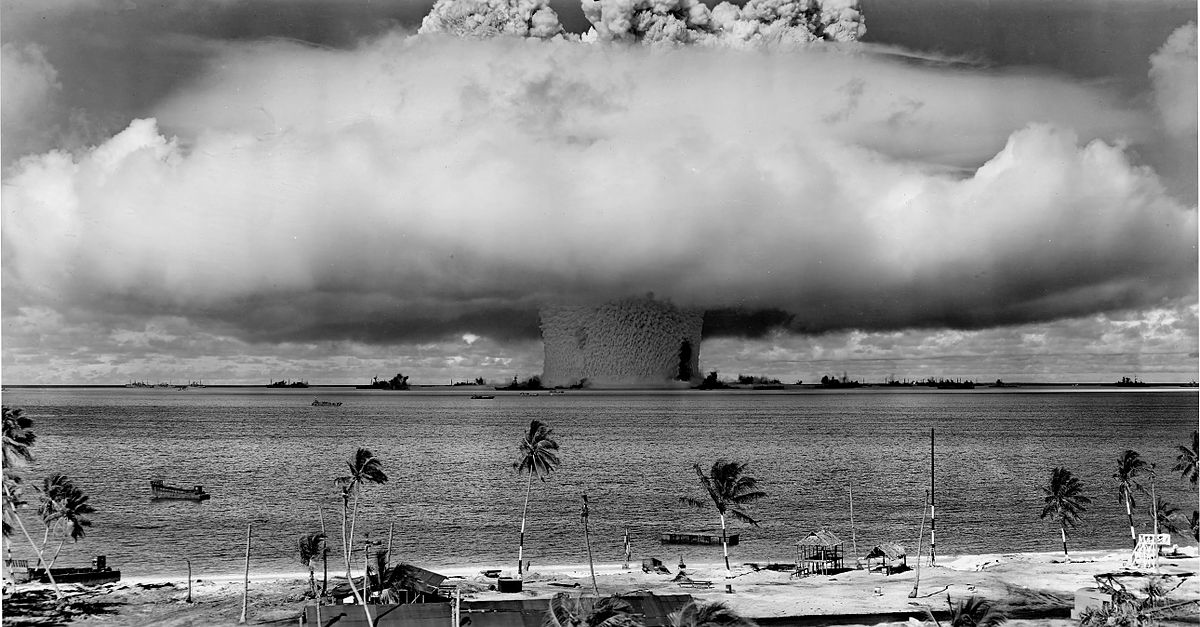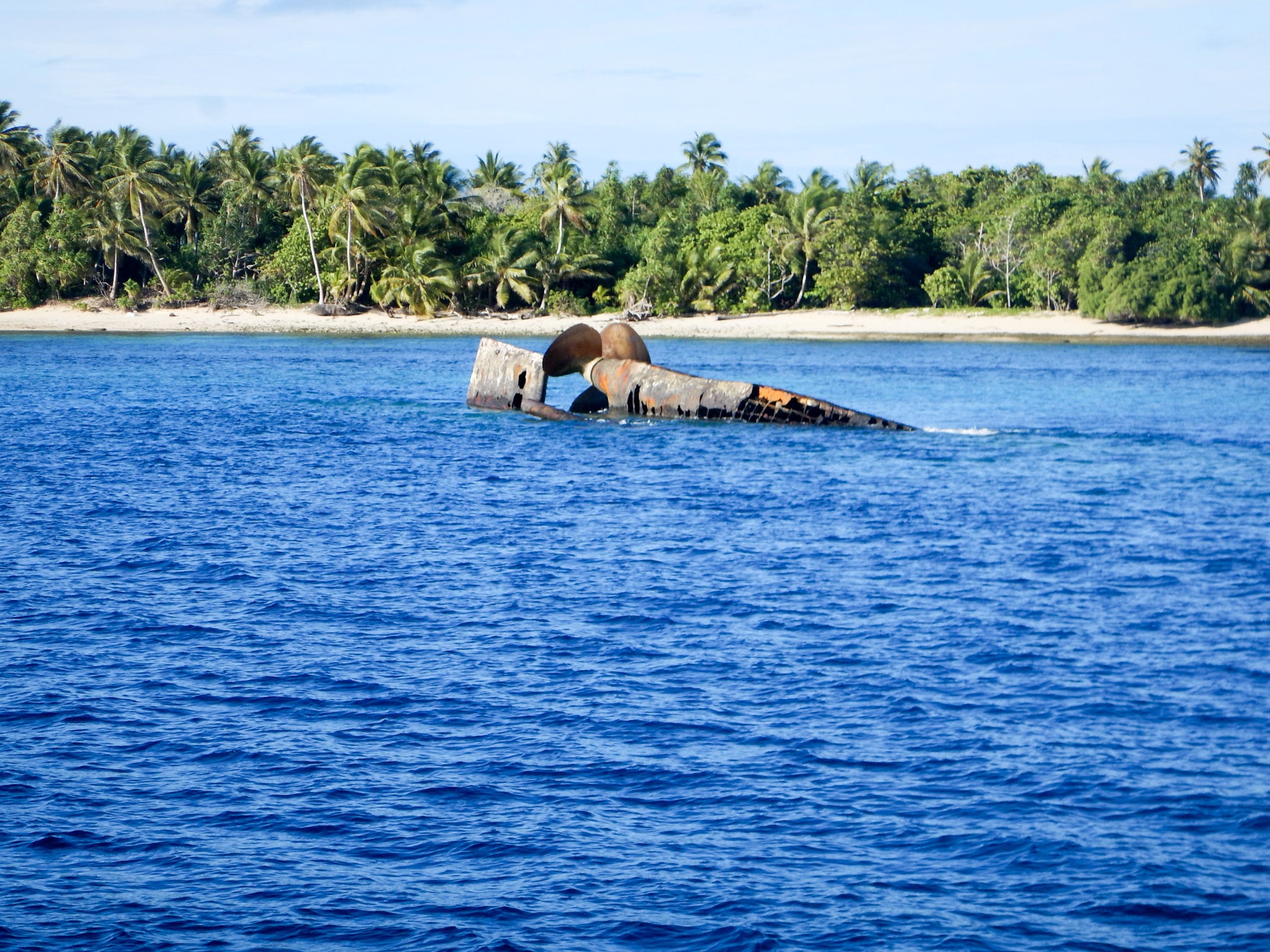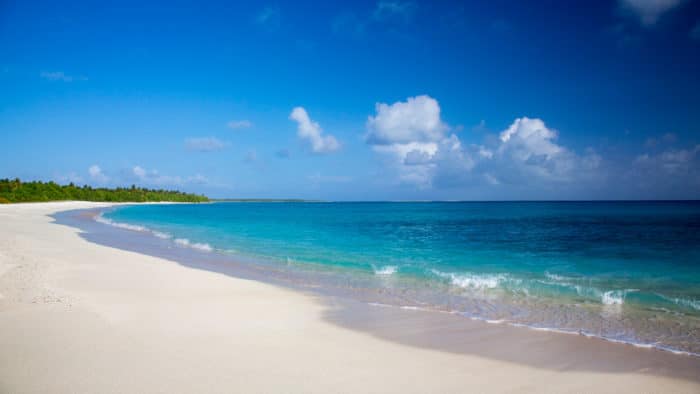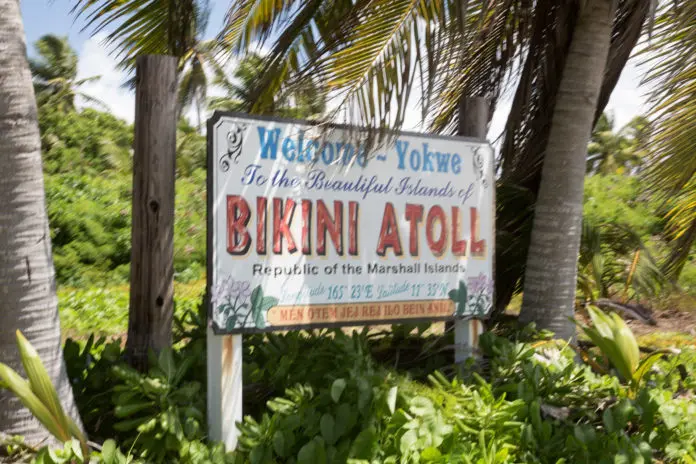“The good of mankind and to end all world wars”
Those were the words of Commodore Ben H Wyatt, the military governor of the Marshall Islands to the residence of the Bikini Atoll in February 1946. The U.S. government had decided there was a need to test nuclear weapons, and their impact on American warships. Bikini Atoll was remote and away from shipping lanes, and became the best candidate as a test location. The Commodore went to the atoll to convince the locals to leave their home for about 6 months. The 167 locals agreed, however, they still have not returned.
Operation Crossroads
Convincing the Bikinians to leave was the first step in what became known to the world as Operation Crossroads. The press was invited and newsreels brought the power of nuclear weapons into the local theater. Ninety-five target ships of different sizes including U.S. battleships, two aircraft carriers, cruisers, destroyers, submarines, numerous auxiliary and amphibious vessels, and three surrendered German and Japanese ships were anchored in the lagoon at precise locations to measure impact on the ships at various distances from the explosions. Animals including pigs, guinea pigs, goats, rats, mice, and grains containing insects were placed on different ships to study the impact on life.
Operation Crossroads consisted of two explosions: Able which was an air blast dropped from an airplane exploding at 520 feet (ca. 158 meters) above the water and Baker which was an underwater explosion from a bomb placed 90 feet (ca. 27 meters) under the surface. Both bombs were 23 kilotons about the same size as that dropped on Nagasaki, Japan. The battleship USS Nevada was the target for Able, however, Able was off target and exploded over a half mile from its target location. It sank five vessels and seriously damaged 14 others. Ships broadside to the shock wave received the most damage. The area where the explosion happened was less dense than the target location, resulting in the lower number.

Baker was located ninety feet below the surface in 180 feet (ca. 55 meters) of water. The bomb was suspended from a landing ship. Nine ships were sunk by the explosion including the aircraft carrier Saratoga. The landing craft disappeared with no traces found. Three other ships were beached in a condition that would have had them sunk. While Able left little radiation, Baker left a level of radiation that was extremely high. Many ships were beyond decontamination capabilities and were later sunk.
The Atomic Heritage Foundation has an outstanding page devoted the operation crossroads that includes a documentary produced by the US Government at the time of the operation. In total there were 23 detonations starting with Operation Crossroads in 1948 until nuclear testing on Bikini ended in 1958. The level of radioactive carbon C-14 in the atmosphere today is twice as high as before the entry of the nuclear age. Scientist believes that this is because of the open-air testing of nuclear weapons mostly at Bikini but also with smaller amounts from other testing sites.
Living There?
In June of 1968, President Lyndon B. Johnson promised that the bikini atoll would be safe to move back to. The following year, an 8-year plan was started to return the previous residences and in 1972 some residence did move back to the atoll. The numbers slowing increases until 1975 when concerns were raised about radiation levels in the water supply. Additional studies showed medical problems and unsafe conditions, leading to the evacuation of the residence in 1978.
The summary was that the atoll is safe from radiation, however, the drinking water, plants, and marine life had a high level of radioactive isotopes that can accumulate in the human body if those items were ingested. The islands were safe if you did not eat or drink anything from there.
Location
Scuba Diving Bikini Atoll
The early 1990s saw an increase in interest Bikini Atoll as a tourist destination. The variety of warships, including the only aircraft carrier at the time that could be dived, was a great interest for scuba divers. The Bikini Atoll Council believed that a tourism industry could be an economic base that would help support the people when the Bikinians eventually returned. Bikini Atoll Divers, operated by the Bikini Atoll Council, open a resort in June 1996. It provided visitors with a unique experience diving the wrecks in the lagoon along with historical presentations and exploring the islands. While the ships and other damage play testament to the powers that were released on the island, divers also saw the recovery. Among the wrecks were healthy reefs and abundant marine life.

Many of the points that made the Bikini Atoll the perfect place for atomic testing, also worked against the resort. The rising cost of bringing in food and water, the multiple legs to get to the island and the reliability of the local air carrier leads to the council decision in 2008 to close the resort. The dream was not dead, it just needed a new focus. A new focus that introduced liveaboard diving. The liveaboards would carry their own food and water and could pick up divers at a location with reliable air service. Diving the atoll is best for technical diving as most of the dive sites are past the limits of recreational divers.
Indies Trader Marine Adventures made an agreement with the Bikini Atoll Council to 2011 to operate their liveaboard the Windward at Bikini Atoll. Since 2011, Indies traders have been providing divers the opportunity of diving the atoll. Currently, they are using the Indies Surveyor. The Indies Surveyor is equipped to cater to technical divers and as an added safety measure has a hyperbaric chamber on board.
Master Liveaboards also has trips to the Bikini Atoll. Dirty Dozen Expeditions does trips to the Bikini Atoll on board the Truk Master under the title of The Critical Experiment. While the Truk Master normally caters to 16 divers, The Critical Experiment trips bring only 11 divers to the atoll on either 10 or 11-day trips. DeeperBlue.com profiled and interviewed Aron Arngrimsson, the founder of Dirty Dozen Expeditions and the expedition leader of the Critical Experiment, which has more details on trips to both Bikini Atoll and Truk Lagoon.
Dive sites of the Bikini Atoll
There are 21 ships that are under the waters of Bikini Atoll. The ships are either at or beyond recreational dive limits, reserving these dive sites to experienced technical divers. These dive sites are the ones most visited:
- USS Saratoga CV-3: The Saratoga, also known as the Fighting Lady and Sara among other names, is the signature dive of the Bikini Atoll. During World War II, the Japanese believed seven different times to have sunk her. She was severely damaged in two torpedo attacks and five kamikaze attacks. While any other ship would have sunk, the Sara survived. She received some damage in the Able explosion, however, none of it was critical. The Baker explosion was strong enough to do her in. Photographs of the explosion show the 880 feet (ca. 268 m) long Fighting Lady weighing over 39,000 tons being lifted from the water. A 100-foot (ca. 30 meters) wave rolled her on to her side. Still, with all that damage, she was still afloat for more than 8 hours before she went under. As a dive site, she has three mooring buoys, one each bow, mid-ship, and stern. The bridge is accessible at 40 feet (ca. 12 meters), deck at 90 feet (ca. 27 meters), and the aircraft hanger at 125 feet (ca. 38 meters). There have been some collapse sections in the last few years as time and the elements have added their own influence.
- HIJMS Nagato: This was one of the most impressive battleships of its era. This Japanese battleship was built in 1919/1920, the Nagato became the world’s fastest battleship on her first speed trail, breaking her own record on her second trial. She was the first battleship to carry 16.1-inch (410-mm) guns. From her radio room, the message that gave the go-ahead for the attack on Pearl Harbor was sent. At the start of WWII, the Japanese Navy had 10 battleships, this was the only one to survive the war. Nagato survives the Able test and is heavily damaged by the Baker test. Four days later she capsized and sank upside down in 170 feet (ca. 52 meters) of water. The hull is at 100 feet (ca. 30 meters).
- USS Arkansas BB-33: An 562-foot American Battleship that saw service in both WWI and WWII. She was the closest ship to LSM-60 which had Baker suspended below. Photos of the explosion show the bow of Arkansas being forced to the bottom leaving the stern out of the water. It believed that the stern continues in a path that left the ship upside down. It took 19 minutes for the ship to sink.
- USS Carlisle AA-69: The USS Carlisle was a WWII armed transport ship, that was mostly used between the U.S. mainland and Hawaii. She was stationed as one of the outer ships for the Able explosion. However, that bomb was delivered off target and the Carlisle was one of the closest to the explosion. She sank upright.
- USS Lamson DD-367: This American Destroyer was stationed at Pearl Harbor but was out on patrol when the Japanese bombed the base. Like the Carlisle, she was a target ship for the Able explosion stationed away from the main target area. Also, like the Carlisle, she took a broadside hit from the off-target Able.
- USS Apogon SS-308: The USS Apogon is a Balao class diesel-electric submarine measuring about 312 feet (ca. 95 meters) long with a beam of just over 27 feet (ca. 8 meters). She was submerged to 100 feet (ca. 30 meters) for the Baker test and sank to the bottom at 48 meters.
- USS Anderson DD-411: The USS Anderson was the first of the Sims Class destroyers. She saw extensive action in both the Atlantic and Pacific operations. The ship was about 348 feet (ca. 106 m) long with a beam of 36 feet (ca. 11 meters). The Anderson was one of the five ships to sink from the Able explosion.
- USS Pilotfish SS-386: The USS Pilotfish is also a Balao class diesel-electric submarine measuring about 312 feet (ca. 95 meters) long with a beam of just over 27 feet (ca. 8 meters). The submarine was a target for the Baker test submerged at 56 feet (ca. 17 meters). The compression wave from the explosion compressed the hull to the point that all the hatches and valves failed, opening the submarine to the sea. Think of it as jumping on a tube of toothpaste until the top flies off.
- HIJMS Sakawa: The Sakawa was a Japanese Agano-class light cruiser 532 feet (ca. 162 m) long with a 49 feet (ca. 15 meters) beam. She was produced late in the war and with fuels supplies being low, remained in Japanese waters during the war. She was the second closes ship to the Able explosion and was sunk by that explosion.
- Prinz Eugen: The Prinz Eugen was a WWII German heavy cruiser. After the war, the cruiser was given to the U.S. as a war prize. The story is that the U.S. really did not want her, but did not want the Russians to have her either. The cruiser was selected as a target ship for Operation Crossroads. Prinz Eugen survived the operation with some damage but only a little structural damage. She was towed to Kwajalein Atoll. A small leak caused her to start taking on water, however, because of the level of radiation repair crews were not sent to fix the leak. Eventually, it capsized. While not at Bikini atoll the Prinz Eugen is still dived as a part of an Atomic Ghost Ship liveaboard. Kwajalein Atoll is the starting point for the dive trips and the Prinz Eugen is normally dived before departing to the Bikini Atoll.

Diving the Bikini Atoll is the dream destination for technical divers who love wrecks.

